From Birth to Breath: The GYROTONIC® Method and Postpartum Recovery
Blog Content // November 11, 2023
Pregnancy and motherhood, universal experiences that transcend borders, backgrounds, and challenges, are journeys filled with transformative moments, unique to each individual. The journey is unique for every individual. In this collective exploration, we delve into the postpartum experiences of Gyrotonic trainers and practitioners to gain valuable perspectives on the role The GYROTONIC® and GYROKINESIS® Methods played throughout their pregnancy and postpartum.
This article is made possible by the work and stories Valeria Mauriz, Gyrotonic Master Trainer Apprentice and Gyrokinesis Master Trainer, has collected while teaching the Gyrotonic Pre and Post Natal courses around the world. Her passion for giving a voice to each woman and her experience through the path of pregnancy, childbirth, and motherhood is what allowed these stories to come to life.
Valeria adds, “One thing is interesting: each is of different countries and backgrounds. They are movers, but each had a different experience with the same subject. It is important for women to be aware of their own bodies; and to listen to their inner needs as well as physical, emotional, spiritual, or psychological needs. Being aware, respecting, and listening to your own body also helps women in their journey to motherhood. These instructors were open to working with these changes in their multiple bodies to allow their transformation, which is not easy. It requires wisdom, compassion, openness, and connection. The Gyrotonic Method helped them to connect with their bodies and listen to their needs in this phase of postpartum and new motherhood.”
Birth is a Movement Event: Adapting with Evolving Needs
Hailing from different corners of the globe yet united as part of the Gyrotonic community, Trainers Erika, Joana, Giulia, Antonia, and Clarissa bring with them the rich tapestry of their cultural and professional backgrounds. Despite the diversity, a common thread runs through their stories—the profound impact of the Gyrotonic and Gyrokinesis methods on their postpartum journeys.
With a combined practice spanning several decades, these Trainers all found solace in the Gyrotonic Method during their pregnancies. They embraced the practice, adapting their routines to the evolving needs of their bodies.
A little about each Trainer:
- Erica Parisi, GYROTONIC® and GYROKINESIS® Master Trainer in Australia
- Has been practicing for 17 years, the first few years were on and off
- Practiced daily during pregnancy, especially leaning on Gyrokinesis movements during pregnancy
- Joana de Brito Cruz, GYROTONIC® Trainer from Portugal
- Has been practicing these methods for 8 years, although not regularly. Of her practice, she says “I tend to give more classes than practice myself”.
- Did continue her Gyrotonic practice during pregnancy, but not regularly
- Giulia Palazzini, GYROTONIC® Pre-Trainer and GYROKINESIS® Trainer
- Has been practicing the Gyrotonic Method since she was 19
- Kept a regular practice during pregnancy and worked with clients until she was 8 months pregnant
- Antonia Valeria D’Ambrosio, GYROTONIC® Pre-Trainer and GYROKINESIS® Trainer
- Has been practicing Gyrotonic for 15 years
- Practiced for the first month, but paused for doctor-prescribed rest for 2 months due to a detached placenta. Enrolling in Valeria’s course enabled her to understand how to best help move her body, but above all, how to move safely. This allowed her to continue her practice until the 41st week of pregnancy.
- Clarissa Braga, GYROTONIC® and GYROKINESIS® Trainer
- Has been practicing the Gyrotonic Method for 16 years
- Kept a regular practice up until 35 weeks of pregnancy, when she stopped working at the studio and stayed quietly at home
Recognizing the importance of movement in the journey of pregnancy, these women share a collective understanding that birth is a movement event. Just as the baby moves through the birth canal, a woman’s awareness and connection to her own movements become crucial. The Gyrotonic and Gyrokinesis methods, with their emphasis on breath, alignment, and fluidity, offered these women a pathway to connect with their bodies during pregnancy.
Valeria wanted to understand how each woman’s practice contributed to their postpartum journey, hear about the biggest challenges of practicing Gyrotonic exercises while pregnant and postpartum, and how practicing these methods during pregnancy and postpartum helped their recovery.
Navigating Challenges: From Pregnancy to Post-Delivery
Despite their shared commitment to the Gyrotonic and Gyrokinesis methods, each woman faced distinct challenges in their practice. Valeria asked them what their biggest challenges of practicing Gyrotonic exercises while pregnant and what body change most called their attention. In their words:
- Erika: “The practicing needed adjustment almost every week, especially at the end. I stopped doing abs around the 7th month. Not being able to move my lumbar spine almost from the beginning was really challenging. And it’s almost incredible for me that I’m really flexible.”
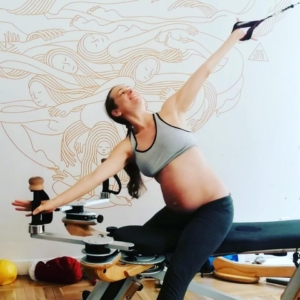
Photo provided by Erica Parisi
- Joana: “My body type is the opposite of what naturally happens in pregnancy. Not augmented curves, lumbar, etc. – the opposite, rectification. It was challenging not knowing what to do and how to adapt to pregnancy. My spine lost even more of its natural curves. There was more accentuated rectification of the neck and lumbar, lack of space in the tibia-tarsia joint, short breathing, and tension in the legs and calves.”
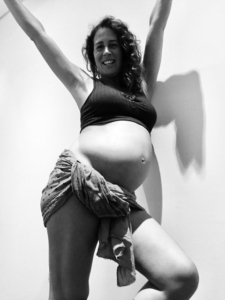
Photo provided by Joana de Brito Cruz
- Giulia: Jokingly, Giulia said putting the upper straps around her feet for the hamstrings was the most challenging part of her practice, something any pregnant person can empathize with. Her true biggest challenge was “keeping time for myself and for my training.” She added that her lumbar spine called for her attention during pregnancy, but she didn’t suffer too badly.
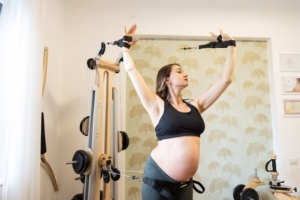
Photo provided by Giulia Palazzini
- Antonia: Despite a detached placenta, after resting and taking courses taught by Valeria, Antonia said, “I decided to enroll in Valeria’s course to understand how to help my body, but above all how to move safely. She is a master of enormous experience who gave me very useful advice that allowed me to do Gyrotonic exercises up to the 41st week of pregnancy, reaping enormous benefits. My pregnancy was, I think, the most peaceful and happiest period of my life.”
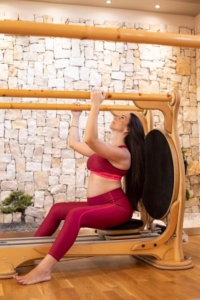
Photo provided by Antonia D’Ambrosio
- Clarissa: “I loved it so much! I would say the hardest thing was having to put myself on the machine and the fact that I didn’t own the space and didn’t have access to the machines all the time.”
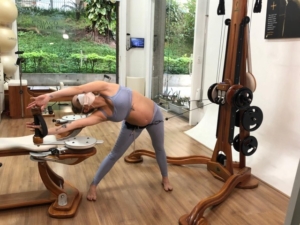
Photo provided by Clarissa Braga
Postpartum Realities: A Tapestry of Experiences
Post-delivery, these Trainers embarked on their postpartum recoveries with varying circumstances. Erika took seven weeks of intentional rest, acknowledging the need for a slow and mindful return. Her biggest challenge postpartum, though, was knowing that she was facing the fact that it would be another journey to be back into her body and it wasn’t happening overnight. Erika remarked, “Out of the changes pregnancy gives you, you need to face the changes from the delivery, which was traumatic for me.”
Joana faced a prolonged recovery and challenges in adapting her practice and finding time for self-care, while Giulia faced the challenge of restoring strength in her abdomen and adductors. Antonia’s peaceful pregnancy gave way to birthing and breastfeeding challenges and tendinitis in the wrists. Clarissa navigated the complexities of regaining muscle tone and spine space, especially the opening of the breast and compensation for pain from holding her baby in her lap and breastfeeding.
Despite their unique journeys, these women found a common thread in the Gyrotonic Method during their postpartum recoveries. Breathing became a focal point for Erika, a tool to reconnect with her body and face birthing trauma. Joana discovered the importance of Gyrotonic exercises in improving her breathing and addressing specific challenges lingering from a difficult birth and long recovery. Giulia looked to the Gyrotonic Postpartum program as inspiration to enhance her teaching, focusing on breath patterns and pelvic floor connections. Antonia leaned on Gyrotonic for energy recharge, finding the method indispensable for a mother’s changing body. Clarissa, too, found Gyrotonic essential for muscle tone, spine space, and navigating the physical toll of breastfeeding.
A Symphony of Recovery: How the Gyrotonic Methods Contributed to Postpartum Healing
Each of these remarkable women faced unique challenges in their postpartum journeys. Yet, through the transformative power of the Gyrotonic Method, they discovered a harmonious path to recovery.
Erika’s slow and mindful return to practice after 7 weeks highlighted the importance of patience in postpartum recovery. “I knew I had to start from my center, which I felt wasn’t there. It’s mentally hard. I even thought it wasn’t going to be back. So I started with the breath – breathing deeply, trying to find a way to reconnect. Facing the trauma and deciding to be strong and fight for health. It was also a good excuse to have some special time for myself and restore my energy and mind.”
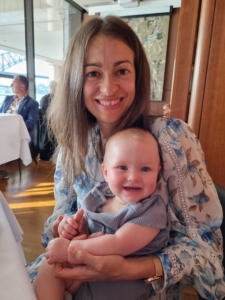
Erika Parisi and baby. Photo provided by Erika Parisi.
For Joana, Valeria’s guidance and the Gyrotonic Method became a crucial element in addressing specific challenges, allowing Joana to navigate the complexities of postpartum recovery, complicated by pain in the tailbone for 8 months. “The Gyrotonic exercises helped me to know the progression of exercises I could do. My breathing improved. Sideways arches and working with the ball helped a lot.”
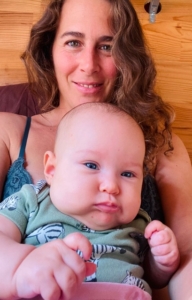
Joana postpartum; photo provided by Joana Cruz.
Giulia approached the recovery journey with love and acceptance, recognizing that it takes time for the body to reclaim its strength. “I opened my studio when my son was 2 months old. It was hard balancing my new life with the studio. I slept badly every night and worked with clients during the day. I tried to keep 1 hour per week for myself, but it wasn’t always possible. The goal was to do some exercises with clients and use the postpartum program with non-postpartum clients. The format helps me to teach – in a better way – the breathing pattern and the connection of the pelvic floor. It is very useful to strengthen the abdominals and legs.”
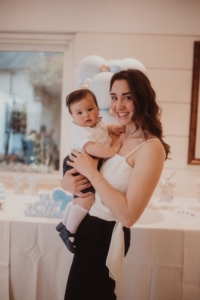
Giulia and her son; photo provided by Giulia Palazzini
For Antonia, the Gyrotonic Method, especially the Postpartum program, remained a constant source of support, helping her adapt to the changes in her body and providing a vital recharge for her energy as a mother. “I feel very changed and the Gyrotonic Method still helps me today. Above all, I always draw from the postpartum program and find benefits. I would say it is an excellent training program aimed at the changes that a woman’s body faces every day in life, even carrying a child who weighs around 10kg. I believe that the Gyrotonic Method is a recharge for the vital energy that every mother should allow herself.”
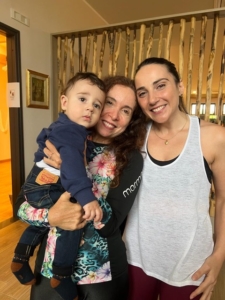
Valeria Mauriz holds Antonia’s baby. Photo provided by Valeria Mauriz.
Clarissa discovered the resilience that Gyrotonic exercises offered in her postpartum journey. “It was essential for the return of muscle tone, space in the spine, especially opening of the breast. In addition, it was a moment for me to feel my body, the changes, and realize how to move with it all.”
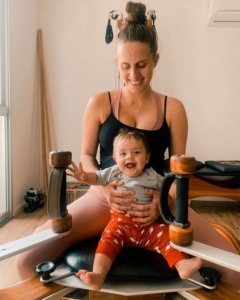
Clarissa’s baby, will be arching and curling before we know it! Photo provided by Clarissa Braga.
In the words of these Gyrotonic Trainers, these methods played a pivotal role in their postpartum recoveries. From reconnecting with their bodies through breath and movement to addressing specific challenges and restoring strength, their Gyrotonic and Gyrokinesis practice became a guiding force in their healing journeys.
The Gyrotonic Method as a Lifelong Companion
As these Trainers and mothers have demonstrated, the journey through pregnancy, childbirth, and postpartum recovery is one of unique challenges, discoveries, and resilience. The Gyrotonic Method, with its emphasis on breath, alignment, and fluidity, becomes a lifelong companion—a source of support, strength, and connection with one’s own body.
In these postpartum stories, the Gyrotonic Method emerges as not just a form of exercise but a holistic approach to wellness. It becomes a medium through which these women navigate the physical and emotional intricacies of motherhood, reclaiming their strength, and embracing the transformative journey with wisdom and compassion.
In the universal language of movement, these Gyrotonic Trainers have found harmony in their postpartum recoveries—a testament to the enduring power of mindful, purposeful movement in every phase of a woman’s life.
Many thanks again to Valeria Mauriz and each of our interviewees for sharing their insightful pregnancy and postpartum experiences.
________________
Gyrotonic Trainers: Learn how to apply Gyrotonic principles to the three trimesters and the postpartum phase in the GYROTONIC® Pre and Post Natal Applications course.
Looking for other articles on pregnancy and postpartum? See our How to Feel Amazing During Pregnancy blog post.
Find Gyrotonic and Gyrokinesis classes near you with the Studio Finder tool.
Learn more about how to become a Gyrotonic or Gyrokinesis Trainer on our Teacher Training page.
